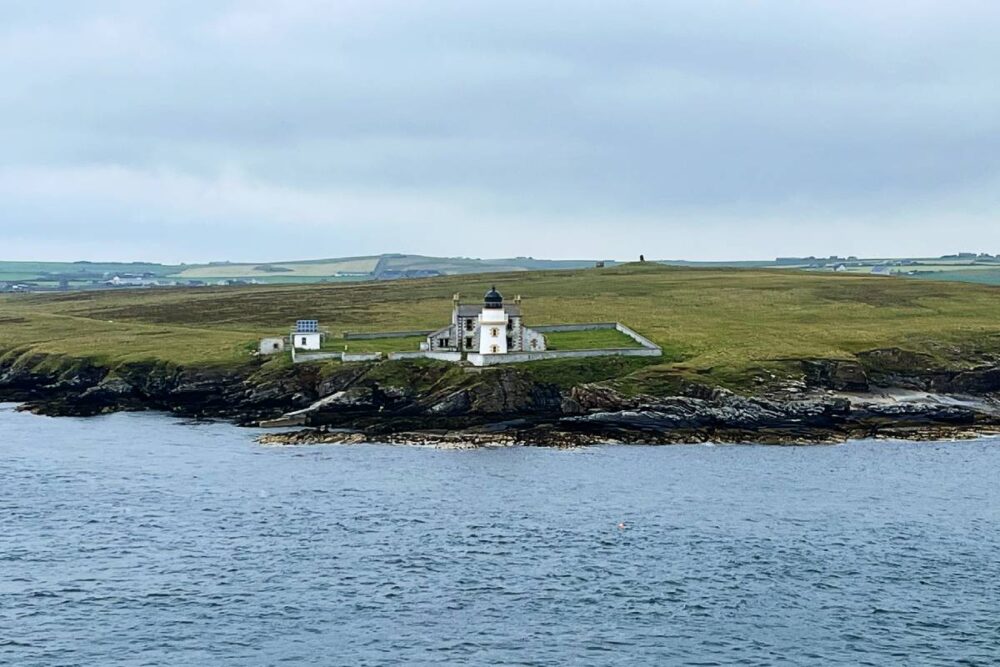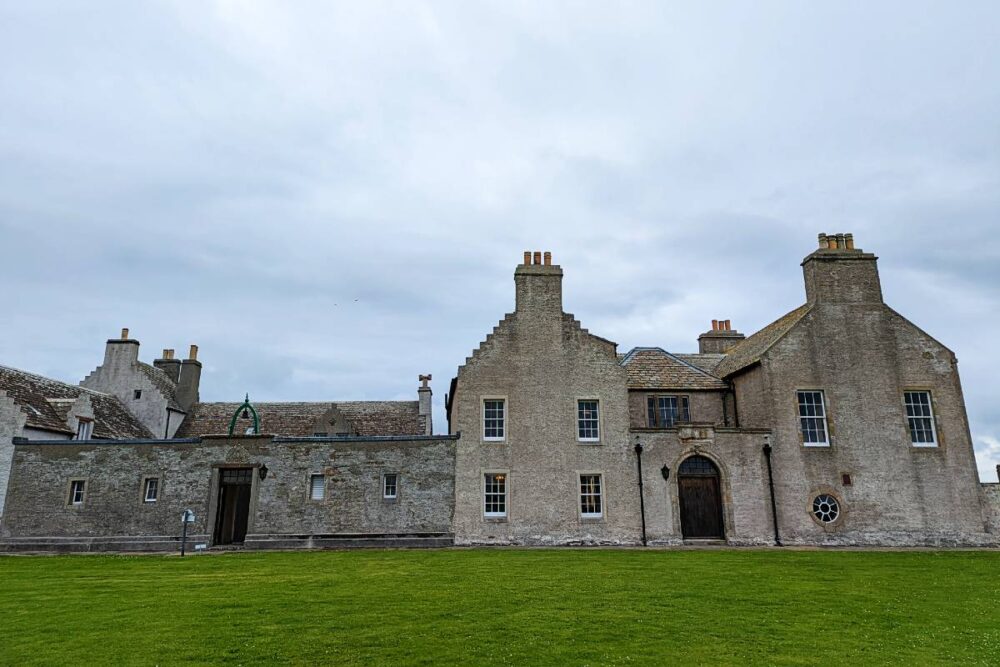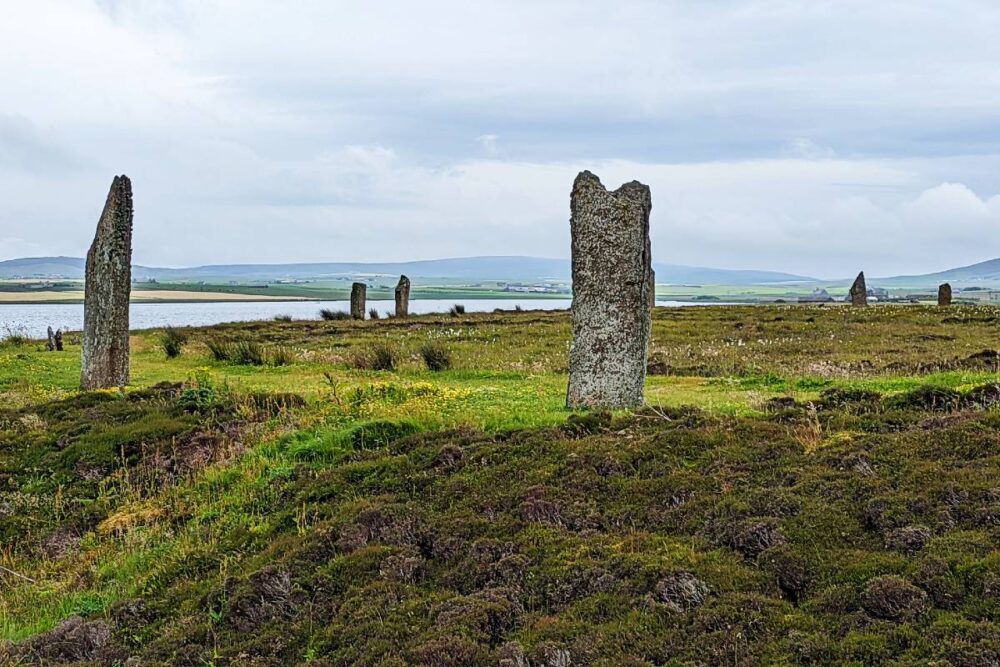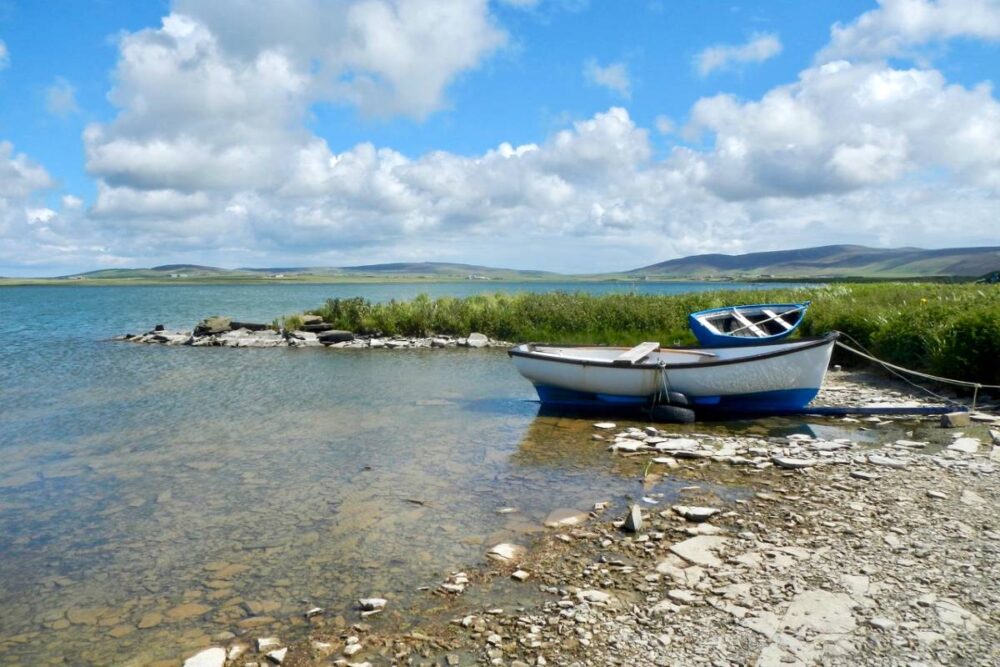From Hollywood writers to modern archaeologists, the Neolithic sights of Northern Scotland inspire imaginations and draw travelers with a penchant for history of the early world.

Orkney is comprised of 70 islands and islets (Photo: Michael C. Upton for TravelMag)
In Indiana Jones and the Kingdom of the Crystal Skull the eponymous hero/archaeology professor conducts a lecture at Marshall College when he is interrupted and given an indefinite leave of absence. His subject at the time, Skara Brae, is a 5000-year-old Stone Age village considered by scientists to be the best-preserved example of its kind in Western Europe.
“There’s no clear evidence as to why its occupants decided to abandon a perfectly healthy environment,” is the last thing Dr Jones has to say about Skara Brae, located off the coast of Scotland, 212 miles (341km) north of Edinburgh. The archaeological wonder is part of the Heart of Neolithic Orkney UNESCO World Heritage Site and its history remains mostly mystery today.
Port of Call
While planning a North Atlantic cruise, I realized I had a spare day to visit Mainland, the largest of 70 islands and islets making up an archipelago north of mainland Scotland collectively known as Orkney. I dove into a rabbit hole of writings on the place, devouring books like the Orkneyinga Saga, the written record of the oral histories of the early seafaring, European explorers who came to Orkney; Orkney: A Historical Guide by Caroline Wickham-Jones, which provides a deep history of Orkney’s ancient civilizations and island life prior to the 12th century; and Northmen by John Haywood, a treatise on the north Atlantic adventurers we know as Vikings covering the years 793 through 1241.
Landing in Kirkwall
Through reading, I developed a favorite character, the Earl of Orkney, Rognvald (1100 – 1158), aka Saint Ronald of Orkney. His remains rest inside a stone pillar at St. Magnus Cathedral in Kirkwall (pop. 9,293), the largest city in Orkney and its main transport hub.

St. Magnus Cathedral is the UK’s northernmost cathedral (Photo: Michael C. Upton for TravelMag)
The cold waves of the North Atlantic dash against the shoreline along the Bay of Skaill in an unrepentant push to devour dirt, sand, and moor. On a map, the ocean looks like a perfect puzzle piece locking into the coast of western Mainland. In 1850, the waves and winds, empowered by a massive storm, swept away centuries of earth to reveal Skara Brae, a Neolithic village built approximately 3100 BCE and abandoned around 2500 BCE (the same time construction began on the great pyramids of Egypt).
Inside the Village
“Late Neolithic Orkney was a sophisticated place,” writes Wickham-Jones of Skara Brae, because it provides unique evidence of daily life. The site is an example of the human transition from Mesolithic nomads to Neolithic settlers, distinguished by ornate furniture—for Stone Age standards—decorated pottery and use-specific tools. Experts like Wickham-Jones even surmise the possible use of indoor latrines in the Skara Brae houses, an advancement well beyond expected Iron Age progress.

Skara Brae homes and furnishings were constructed of local flagstone (Photo: Michael C. Upton for TravelMag)
Standing above the settlement, looking down into the houses no bigger than a one-bedroom city apartment, I can envision the communal aspect of Neolithic life. Stone Age families passed through narrow doorways to find themselves in front of a hearth used for cooking, heat, and light. A stone dresser at the far end of the room may have been used for storage or as a display for special items like Grooved Ware pottery and jewelry made from animal bones.
The construction is all stone. Bed enclosures, storage spaces, and even watertight coolers are constructed from Orcadian flagstone, which is relatively easy to split, making it the perfect building material on an island almost devoid of timber. Any found driftwood arriving on the shores from what is now Canada may have been used to fashion roofs with thatched grass and mud.
The Skara Brae Complex
Ten buildings, exteriors constructed of sandstone and insulated with midden, are linked together by slender passageways except for building eight, which sets apart to the south of the other buildings. Scholars believe building eight, with its lack of bed structures, amount of found pottery shards, and spacious layout complete with an abundance of side chambers and cupboards served as a workhouse. This building is the easiest to envision as a completed form since layers of midden and earth outside the other buildings give the illusion the houses are built underground as visitors view the structures from a paved footpath above.

Visitors view the unearthed village of Skara Brae from an elevated path (Photo: Michael C. Upton for TravelMag)
Most experts agree the residents of Skara Brae were farming families who enjoyed a peaceful existence in the New Stone Age for over 20 generations. They may have travelled elsewhere in Europe or had contact with outside cultures, as evidenced from artifacts collected at the site.
Passed into government hands in 1920, at which time a protective seawall was built, a simple uncovering of the site took place. In 1972 and 1973 a thorough excavation of Skara Brae provided carbon dating. The dig discovered thousands of Neolithic artifacts, such as early oil lamps, carved stone balls, and decorative pottery. Some of these items are on display at the Skara Brae visitors center and The Orkney Museum in Kirkwall.
The Laird Who Found Skara Brae
About 300 meters from Skara Brae, a safe enough distance away from the surf and tides, stands quite the contrast in construction. Bishop George Graham constructed the sand colored Skaill House mansion in 1620 and in the year of the great storm, 1850, the building was the home of William Graham Watt, the 7th Laird of Breckness.
Watt discovered the unearthed Skara Brae on his property after the storm. Today, a self-guided tour through the home is included with Skara Brae admission and interior displays contain Neolithic and Iron Age items found around the property.

Skaill House, home of William Graham Watt who discovered Skara Brae in 1850 (Photo: Michael C. Upton for TravelMag)
Leaving Skara Brae
Driving east from Skaill House toward the Ring of Brodgar, lapwings and golden plovers nest in open heathland. Birds are in abundance here partly because the island is insecticide free; the humans of Mainland are proud to support a coexistence with both history and nature, helping to maintain hundreds of species of birds.
Many of these birds find protection in the 13 nature reserves maintained by The Royal Society for the Protection of Birds (RSPB). These reserves often overlap historic sites administered by the institution established to investigate and care for Scotland’s historic sites, Historic Environment Scotland. The rolling horizon of western Mainland is filled with fertile farms and dotted with lochs, the largest being the lochs of Stenness and of Harray. The Ring of Brodgar comes into view as the land between these two lochs narrows to less than 400 metres.
Ring of Brodgar
Assembled in a nearly perfect circle 104-metres in diameter, upright stones caress the sky as visitors follow a path to the third largest stone circle in the British Isles. On foot, the eye spots low growing flowers like the Scottish primrose, sea aster, and common sea-lavender, the fuchsia, white and violet blending into the low-growing evergreen shrubs and windswept grass in various shades of green and tan.

Birds enjoy peace and safety throughout the Heart of Neolithic Orkney UNESCO World Heritage Site (Photo: Michael C. Upton for TravelMag)
“Please keep to the perimeter footpath,” reads a metal plate just outside the ring. The ring itself, originally cut 3 metres deep into the bedrock and widened out almost 10 metres by Neolithic residents, circled a grouping of erect stones, of which 36 still stand today. Outer stones mark spots away from the ring and archaeologists speculate the site originally contained 60 or more stones, mined from various parts of Orkney. Nature and an early indifference to preservation have done away with the missing stones here and at some other sites around Orkney.
The Comet Stone
The crowd is small and reverent, and the wind blowing off the loch whistles past my ears. I sit on a patch of worn grass and let my imagination take over. What were these stones for, and what did the ring look like at its prominence? I spot a smaller stone off toward the road, the Comet Stone, standing guard on a low mound in the heather and meadowsweet.
In the 1970s, a theory connected the 1.75-metre-tall rock with the Ring as an astronomical observatory, citing the stone could stand as a backsight for a notch on Mid Hill. The point on the hill is where the moon rests at a minor lunar standstill. All of this and everything in my imagination is conjecture. Little research and excavation has taken place at the Ring of Brodgar, making it—like many Neolithic sites in Orkney—a chamber of secrets for future archaeologists.

Remains of 36 upright stones form the Ring of Brodgar (Photo: Michael C. Upton for TravelMag)
Stones of Stenness
Less than two kilometers away, just past where the two large lochs mingle into one, the road narrows at the Ness of Brodgar. Standing up to six metres tall, the four Stones of Stenness (once numbering 10 or 12) tower along the roadside and are part of what archaeologists believe to be a highly utilized location during early Neolithic times.
Originally constructed circa 3100 BCE, the stones and the surrounding ring—now lost in the field due to years of plowing—are several centuries older than the Ring of Brodgar. Experts know little about the formation, but suggest this ring was home to special ceremonies during Neolithic times. The flat sides of the stones reflect sounds like hand claps and shouts and align with features on the nearby island of Hoy to the south.
Just as at the Ring of Brodgar, it is easy for the imagination to wander. Strangers are eager to share their theories on the rings’ purpose, from alien civilization landing zones to simple calendars. But, like the disappearance of the residents of Skara Brae, the rings’ meaning is a mystery lost to time.
Sights Around the Stones of Stenness
Archaeologists are hoping not all the answers are lost and in 2022 they resumed excavation of the Ness of Brodgar, a collection of free-standing Neolithic structures surrounded by a stone wall located between the Stones of Stenness and the Ring of Brodgar. Wickham-Jones describes the Ness of Brodgar as “a complex of monumental structures of a scale previously unimagined for the Neolithic anywhere in the United Kingdom.”
Work on the site, managed by the UHI Archaeology Institute and the Ness of Brodgar Trust, will continue into the future and visitors are welcome to spectate. Here on the edge of the water, white swans steal the attention as they float across the Loch of Harray.

The view is splendid over the Loch of Harray (Photo: PunkToad via Flickr / CC BY 2.0)
North of the Stones of Stenness, within easy walking distance, stands the Barnhouse Settlement. Excavation of this site revealed at least 13 houses inhabited from 3200 to 2900 BCE. The visible structure seen today, with similar construction to dwellings at Skara Brae, is a reconstruction based on excavations performed in the 1980s.
Sights Off Mainland
For the Neolithic tourist with limited time in Orkney, the hours are best spent on Mainland discovering Skara Brae and the sites making up the Heart of Neolithic Orkney UNESCO World Heritage Site, but other islands hold more archaeological treasures. At last count, there are at least 35 sites across 10 islands. The Knap of Howar on Papa Westray is a farmstead constructed around 3500 BCE and exhibits signs of even earlier occupation.
Neolithic homes similar in design to Skara Brae have been unearthed at the Links of Noltland on Westray, and the Stone of Setter on Eday marks the center of several chambered tombs. Other than the Ness of Brodgar, Swandro on the coastline of Rousay is the largest ongoing archaeological excavation in Orkney and has unearthed the remains of a Neolithic chambered tomb, Iron Age roundhouses, and Pictish buildings.
More on Mainland
Mainland itself has even more to offer for those who can stay longer, including Maeshowe, a well-preserved tomb open to curious visitors; another, yet smaller, tomb named Unstan which yielded important pottery and arrowhead finds; and several small cairns and single, standing stones around the island.

Brodgar the Peedie Puffin welcomes everyone to Orkney (Photo: Michael C. Upton for TravelMag)
At latitude 49 degrees north, summer days in Orkney are long and bright. Seventeen hours of daylight provides an amazing amount of time for a daytrip, even as sites like Skara Brae, Skaill House, and the welcoming businesses in Kirkwall stick to a standard workday schedule.
When it comes to the prehistory of the islands, everything I read primed me for what I found on Orkney, but nothing prepared me for the level of excitement these Neolithic sites stirred in my imagination. More often I should heed the advice of Dr. Jones, “If you want to be a good archaeologist (tourist), you gotta get out of the library!”